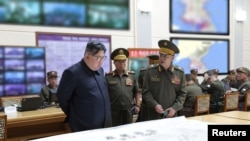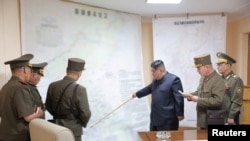North Korea’s military has practiced occupying all of South Korea as part of a counterstrike exercise, a type of exercise involving all the North’s military never before reported by its state media. The exercise was followed by a "tactical nuclear strike drill" overnight.
Two posts on the North’s Korean Central News Agency on Thursday reporting the exercises came as the U.S. and South Korean militaries wrap up an 11-day defensive drill dubbed Ulchi Freedom Shield, the largest in scale in years.
The U.S.-South Korea computer-simulated exercises, complimented by dozens of field drills, had an emphasis on practicing a coordinated response against a North Korean nuclear attack.
KCNA images showed a bespectacled Kim Jong Un reviewing battle plans against a backdrop of blurred-out maps. He studied "the command drill involving the whole army" Tuesday, "aimed at occupying the whole territory of the southern half by repelling the enemy’s sudden armed invasion and switching out to an all-out counterattack," KCNA said.
Kim was accompanied by the North’s Korean People’s Army Marshal Pak Jong Chon and Defense Minister Kang Sun Nam, it added. Kim gave a long list of advice, including conducting "super-intense strikes at pivotal military command centers, military ports, operational airfields … and core objects whose destruction may cause a series of socio-political and economic chaos."
In a separate report, North Korea said the two tactical ballistic missiles it fired Wednesday just before midnight constituted a "tactical nuclear strike drill" in retaliation to Ulchi Freedom Shield and the B-1B bomber deployed by the U.S.
It said the nuclear strike mission was successful, accurately exploding in mid-air "at a preset altitude of 400 meters above the target island." The drill simulated "scorched earth strikes at major command centers and operational airfields" of South Korea "military gangsters," KCNA added.
Seoul’s Joint Chiefs of Staff overnight told reporters in text messages it detected a pair of short-range ballistic missiles fired from Pyongyang’s Sunan area around 11:40 to 11:50 p.m., launched toward waters east of the peninsula. They flew some 360 kilometers before impact, the details of which are being analyzed with U.S. counterparts.
Analysts in Seoul note that the 360-kilometer flight distance, if angled a different way, would target military assets in South Korea.
Japanese Prime Minister Fumio Kishida condemned North Korea’s ballistic missile launches as "absolutely unacceptable" Thursday, underlining that they are repeat violations of multiple United Nations Security Council resolutions. He added Tokyo has lodged a protest against Pyongyang.
South Korea's Unification Ministry, in charge of inter-Korean affairs, strongly condemned Kim Jong Un "for blatantly expressing his intentions of military attacks on South Korea, using the USF joint exercises as an excuse." It warned Pyongyang must realize continuing its military provocations would only undermine its security, while strengthening South Korea, the U.S. and Japan's resolve.
Also Thursday, South Korea’s Joint Chiefs Chair Kim Seung-gyeom hosted U.S. Strategic Command Commanding General Anthony J. Cotton. The two pledged to further deepen their cooperation towards deterring and overwhelmingly responding to any threat by North Korea to use its nuclear weapons, Seoul’s defense ministry said.










